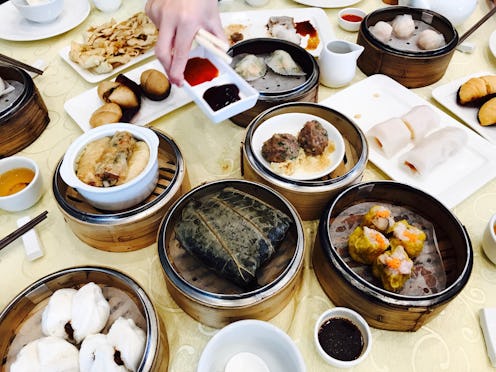
When I was growing up in Phoenix, Arizona, my family and I had a weekend tradition: Dim sum for lunch. Most Sundays after church, we’d drive to our preferred dim sum restaurant of the moment (in elementary school, it was C-Fu Gourmet; in high school it shifted over to China King) for yum cha — Cantonese for “drink tea,” but used broadly to describe the meal of dim sum. Our family would sit at a large, round table as carts circled around us, transporting steamer baskets loaded with har gow (shrimp dumplings), char siu bao (buns stuffed with barbecue pork), lo mai gai (lotus-leaf-wrapped sticky rice), and saucy chicken feet. (There would also be fried egg rolls and crispy doughnut-like dumplings filled with pork, but my mom never let us get them because they were yeet hay. Sigh.)
I’d always just sit back and let my parents order; they would hover over each roving cart to see what it offered, before selecting a dish and handing the paper ticket over to the restaurant staff to be stamped. After all, my parents knew the names of everything and could order far more effectively than I ever could, given my limited Cantonese. The meal was our family’s tradition, something we did with near clockwork regularity. We’d see familiar faces at the restaurant, from staff members to family friends who were also out for their Sunday tradition, and it was the perfect time to catch up and see how they were doing. The next week, we’d repeat the process over again.
But like most things that are taken for granted, I didn’t appreciate how much dim sum represented home, and family, until I moved away.
About a decade ago, I came to New York City for graduate school, and have been here ever since. I never struggled majorly with homesickness; it’s not that I don’t love and miss my family dearly, but I think I’ve just become very good at compartmentalizing my feelings. However, as is the case for many people, the quickest way for me to feel comforted when I am feeling a little homesick is to eat food I grew up with. Not just dim sum, but dishes like jook, hot and steaming and dotted with chopped-up bits of century egg; bak kut teh that simmers for hours until it’s perfectly peppery; shrimp noodles that are *chef’s kiss* when stir-fried in oil with a bit of minced garlic. I love to eat — I’ve written before about how it’s my favorite way to learn about other cultures — but when it comes to this food, the appeal is moreso in the familiarity, the connection to my family.
Dim sum is no exception. And while there's no shortage of reliable spots here in NYC where I can go and have it, I’ve come to learn that, without that Sunday ritual in place like I had growing up, if I want yum cha, I have to take matters into my own hands. This has, through the years, resulted in me suggesting it as a meal option every chance I get, whether with roommates, in-city friends, out-of-town visitors, or volleyball teammates. We need to celebrate a birthday? Let’s get dim sum! Bored on a Saturday? Let’s get dim sum! It’s the coldest day of the winter and we’ll have to wait outside for a table, but who cares because I’m craving some dan tat? Let’s get dim sum!
Fortunately, because dim sum is delicious, I’ve never had to try very hard to convince people to join — and before long, I found myself taking on the role that my parents had when I was a kid. I’m now the one peering into the carts, choosing which version of the rice noodle rolls we should get for the table. Without me even realizing it, dim sum has grown from being a tradition that I just shared with my immediate family, to a way to bring people into my family. It’s become a joy for me to take friends for their first time, so they can discover their own favorite dishes. It’s even become something my father-in-law and I bond over whenever he visits my husband and I — we’re usually the only two at the table who will touch (OK fine, more like inhale) the tripe. It’s also the first meal that was shared together with family after my wedding: my new family members from my husband’s side enjoying bowls of sweetened silken tofu, right alongside my aunts and uncles who’d flown in from Hong Kong for the celebration. When I share dim sum with people now, I feel like, in a way, I’m sharing part of my heart.
That feeling is what’s behind this special food edition of Bustle’s All American: to highlight the food traditions that really define life lived with family and friends here in America, and to celebrate our upbringings — ones that are so exclusively ours, yet cross cultural bounds and are relatable in ways we would never expect. And especially at this time of year — the holidays are infamous for unearthing all matter of warm, sad, happy, conflicting, and otherwise complicated feelings, after all — we wanted to take a look at how food, specifically, shapes our uniquely American experiences.
So this is my story of dim sum — and how, for me, it’s so much more than just the dim sum. It’s amazing how something so ordinary-seeming can actually evolve to carry more meaning than you’d expect. Just as it was likely a small way for my parents to experience a bit of home away from their homes, it’s become a way for me to feel a bit of home away from home, too.